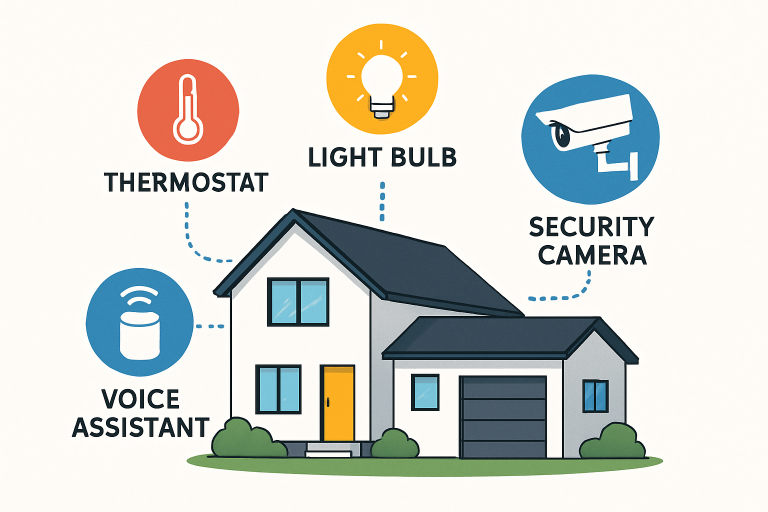
How Smart Technology Is Shaping the Future of Home Living
Key Takeaways
- Smart homes boost convenience with interconnected devices and voice-activated controls.
- Eco-friendly tech helps reduce utility bills and supports sustainable living.
- Advanced security systems offer greater peace of mind and real-time monitoring.
- Wellness is enhanced by smart features that track and support household health.
- Widespread adoption still faces obstacles, including security risks and higher initial investment costs.
Smart technology is bringing about a profound transformation in the way we live, turning homes into cohesive hubs of automation and intelligent functionality. From controlling lighting with the touch of a button to receiving real-time security alerts on your smartphone, these advancements simplify daily routines and create environments that are comfortable, efficient, and secure. For those interested in integrating new tech features into home purchases in vibrant neighborhoods, many Back Bay, MA real estate agents report a growing demand from buyers for connected homes and smart amenities as part of modern luxury living.
With the smart home market poised for even greater innovation in the coming years, homeowners now have more tools than ever to personalize their living spaces while maximizing convenience and sustainability. This article examines the key trends shaping the future of home living, from improved energy efficiency to the latest advancements in health and safety technologies.
Enhancing Convenience with Interconnected Devices
One of the biggest advantages of smart home living is the ability to streamline daily tasks using interconnected devices. Voice-activated smart speakers such as Amazon Echo and Google Home act as control hubs, allowing users to manage everything from door locks to kitchen appliances with simple spoken commands. This hands-free approach is particularly beneficial for multitasking or supporting independent living among older adults and individuals with disabilities. According to CNET’s guide to smart homes, today’s technologies can also be programmed to follow routines, like turning on lights at sunset or starting the coffee maker at a specific time, blending seamlessly into everyday life.
Boosting Energy Efficiency
Smart technology plays a key role in reducing energy use and making homes more environmentally friendly. Learning thermostats, such as Nest and Ecobee, adapt to your living patterns, automatically adjusting temperatures to minimize energy waste while maintaining comfortable interiors. Smart lighting systems can automatically turn off when spaces are empty or adjust brightness according to the time of day. The U.S. Department of Energy highlights the impact of LED and smart lighting, noting that these solutions not only lower power bills but also contribute to nationwide sustainability goals.
Advancing Home Security
From facial recognition doorbells to remotely monitored alarm systems, smart security technology is raising the standard for household protection. Homeowners can check live video feeds, get immediate alerts, and even communicate with visitors, all from their smartphones. AI-powered systems are becoming adept at distinguishing between residents, guests, or potential threats, resulting in fewer false alarms.
Promoting Health and Wellness
Health and wellness integration is a rapidly growing trend in smart home technology. Devices such as air quality monitors, connected blood pressure cuffs, and smart mattresses enable residents to monitor their personal wellness from home. Wearables can sync seamlessly with home assistants to track sleep, activity, and even warn users about irregular vital signs. For families and those managing chronic conditions, access to real-time data and analytical insights encourages proactive health management.

Addressing Challenges in Smart Home Adoption
Despite the impressive array of benefits, smart home adoption is not without hurdles. Internet-connected devices can pose privacy risks, with concerns that sensitive data may be improperly accessed or shared. Security vulnerabilities, if not properly managed, might expose homes to hackers. The higher startup cost of outfitting a home with networked sensors and appliances is also a significant consideration, particularly for larger properties.
The Future of Smart Home Technology
The coming years promise even more exciting innovations in home automation. The wider rollout of 5G will enable instantaneous data exchanges among devices, leading to smarter automation and enhanced user experiences. Artificial intelligence is expected to make home systems more predictive, adjusting lighting, temperature, and security in anticipation of resident routines. With increasing focus on eco-friendly living, advances in solar energy storage and water reclamation technologies will merge with smart networks to create truly sustainable homes. As technology gets smarter and more intuitive, homes will increasingly become personalized sanctuaries tailored to every occupant’s needs and lifestyle. Smart technology is fundamentally shaping the future of home living—paving the way for residences that are more secure, sustainable, and in tune with the people who inhabit them. As innovation continues to unfold, homeowners can expect to benefit from increased comfort, enhanced safety, and unparalleled convenience for years to come.



Average Rating